Description
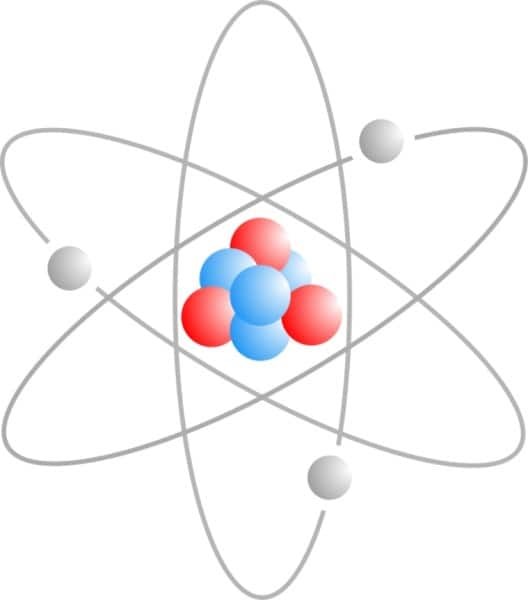
Disclaimer: Copyright infringement not intended.
Context
- In a world grappling with the complexities of nuclear weapons, recent events have reignited discussions about their history, ethical implications, and the formidable scientific processes that underpin their creation.
- President Vladimir Putin's provocative statements, the poignant deliberations at the G7 meeting in Hiroshima – a city scarred by a nuclear strike – and Christopher Nolan's cinematic venture 'Oppenheimer' have collectively thrust nuclear weapons into the limelight.
Details
Unveiling the Atom: Essence of Matter
- Central to comprehending the potency of nuclear weapons is a journey into the atom, the fundamental unit of matter.
- Atoms, composed of protons, neutrons, and electrons, form the elemental constituents of our universe.
- Protons and neutrons congregate within the nucleus, while electrons orbit this core, constituting a delicate balance that defines each element's nature.
Introduction to Nuclear Bombs
- Nuclear bombs, also known as atomic bombs or nuclear weapons, are highly destructive devices that release an enormous amount of energy through nuclear reactions.
- These reactions involve manipulating the fundamental forces that hold atomic nuclei together, resulting in an unprecedented release of energy.
Basic Principles of Nuclear Bombs
Nuclear bombs operate on two primary principles: nuclear fission and nuclear fusion.
Fission-Based Nuclear Bombs (Atomic Bombs)
- Fission-based nuclear bombs, commonly referred to as atomic bombs, exploit the process of nuclear fission, where the nucleus of an atom is split into smaller fragments, releasing energy.
- The key elements used in fission-based bombs are uranium-235 (U-235) and plutonium-239 (Pu-239).
- A supercritical mass of fissile material is assembled. This mass is sufficient to sustain a chain reaction, where each fission event releases neutrons that trigger subsequent fission reactions.
- Neutrons are introduced to the fissile material, initiating fission reactions.
- During fission, the nucleus of the atom splits into two smaller nuclei, releasing energy, gamma radiation, and additional neutrons.
- The energy released is in the form of kinetic energy of the fragments, gamma radiation, and kinetic energy of neutrons.
- This energy creates a powerful explosion, generating shockwaves, heat, light, and ionizing radiation.
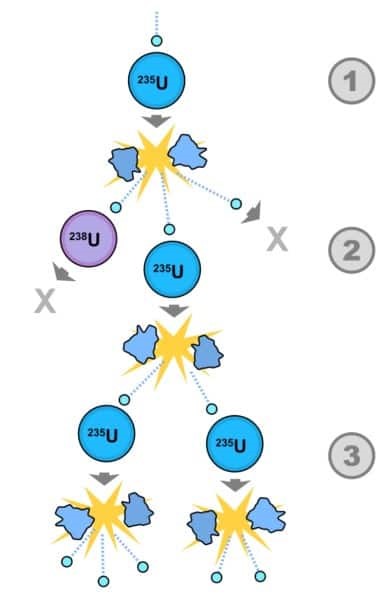
Disclaimer: Copyright infringement not intended.
Uranium-235: Elixir of Fission
- Uranium-235 (U-235), a rare isotope of uranium comprising less than 1% of natural uranium, assumes paramount significance in nuclear fission.
- When a U-235 nucleus absorbs a neutron, it undergoes destabilization, fracturing into lighter elements and liberating a torrent of energy. This energy becomes the lifeblood of atomic bombs.
Chain Reaction Unleashed
- The rupture of a U-235 nucleus cascades into the release of more neutrons, initiating a chain reaction.
- These liberated neutrons collide with neighboring U-235 nuclei, sparking further fission reactions and cascading into an exponential release of energy.
- The profound intensity of this energy becomes the linchpin of nuclear weaponry.
Enrichment
- Yet, the preeminent challenge lies in enriching uranium, as naturally occurring uranium predominantly comprises non-fissionable U-238.
- To attain weapons-grade material, uranium must be enriched to amplify the U-235 concentration.
- This intricate process, replete with technological intricacies, underscores the dual-purpose nature of nuclear technology, serving both power generation and warfare.
Triggering Mechanisms
- Crucial to nuclear weapons is the precise triggering of nuclear reactions.
- Preventing accidental detonation necessitates meticulous maintenance of subcritical masses until the opportune moment.
- Gun-type designs employ collision-induced supercriticality, while implosion designs rely on rapid compression of subcritical masses to initiate an explosion.
.jpg)
Fusion-Based Nuclear Bombs (Thermonuclear Bombs)
- Fusion-based nuclear bombs, also known as thermonuclear or hydrogen bombs, utilize nuclear fusion, where two light atomic nuclei combine to form a heavier nucleus, releasing energy.
- The primary stage of a thermonuclear bomb is a fission bomb, which creates the conditions necessary for fusion in the secondary stage.
- Primary Stage (Fission):
- The primary stage involves a fission bomb that generates high temperatures and pressures.
- X-rays and high-energy particles produced by the fission process irradiate the secondary stage.
- Secondary Stage (Fusion):
- The secondary stage contains fusion fuel, typically deuterium and tritium isotopes of hydrogen.
- The X-rays and particles from the primary stage heat and compress the fusion fuel, initiating fusion reactions.
- Fusion releases a significantly larger amount of energy compared to fission.
- Deuterium and tritium, isotopes of hydrogen, coalesce under extreme heat and pressure, propelling an explosion surpassing fission's might.
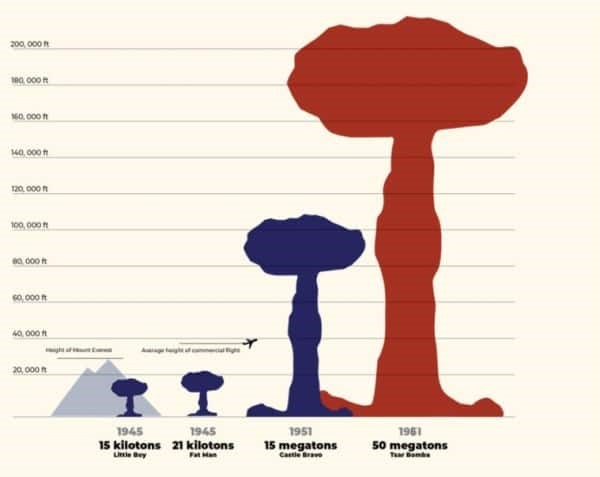
Detonation Mechanisms
Nuclear bombs are detonated using various mechanisms that ensure the precise timing and conditions for nuclear reactions.
Implosion-Type Design
- In implosion-type bombs, conventional explosives compress the fissile material into a supercritical mass.
- The compression increases the density of the fissile material, leading to a more efficient chain reaction.
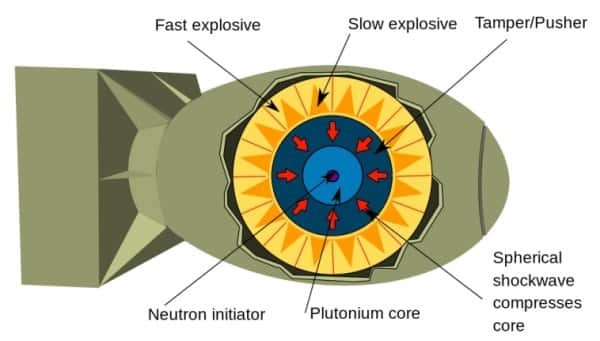
Gun-Type Design
- Gun-type bombs use conventional explosives to propel one subcritical mass of fissile material into another, creating a supercritical mass.
- This design is simpler but less efficient and requires more fissile material.
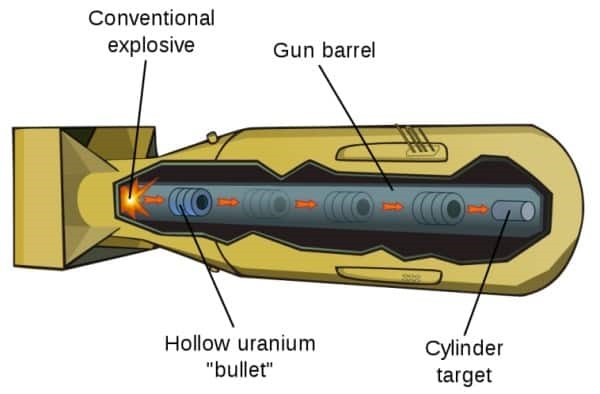
Initiators and Timing
- Initiators like neutron initiators or nuclear initiators ensure the precise initiation of the nuclear reactions.
- Timing mechanisms ensure that the compression and initiation of reactions occur simultaneously for maximum efficiency.
The Energy Spectacle
The detonation of a nuclear weapon begets a multifaceted spectrum of destruction:
- Blast Wave: A seismic shockwave obliterating structures and claiming lives.
- Thermal Radiation: Incandescent heat and light igniting fires and searing flesh.
- Intense Heat: Consuming fires and vaporizing matter through scorching temperatures.
- Radiation: Immediate and residual radiation, haunting health and ecosystems.
Nuclear Proliferation and Deterrence
- The spread of nuclear weapons and technology is a global concern.
- International agreements, such as the Treaty on the Non-Proliferation of Nuclear Weapons (NPT), aim to prevent the proliferation of nuclear weapons.
- These agreements encourage disarmament and promote the peaceful use of nuclear energy.
- Some countries possess nuclear weapons as a deterrent against potential adversaries.
- The concept of nuclear deterrence suggests that the threat of retaliation with nuclear weapons discourages aggression.

Conclusion
The resurgence of nuclear weapons in global discourse underscores the ethical crossroads they embody. Proliferation concerns and deterrence strategies evoke intricate global challenges. Agreements and treaties aim to curb the diffusion of nuclear weapons, navigating the delicate equilibrium of power and peace. In the nexus of scientific exploration and humanity's preservation, the comprehension of nuclear weapons' science exposes both our capacity for innovation and the precipice of annihilation. As discussions persist, the international community grapples with the equilibrium between scientific enlightenment and safeguarding our shared future.
|
PRACTICE QUESTION
Q. Examine the ethical dilemmas associated with nuclear weapons and their global implications. How do international agreements and treaties seek to address these challenges? (250 Words)
|
https://indianexpress.com/article/explained/explained-sci-tech/the-science-behind-a-nuclear-bomb-8878006/















